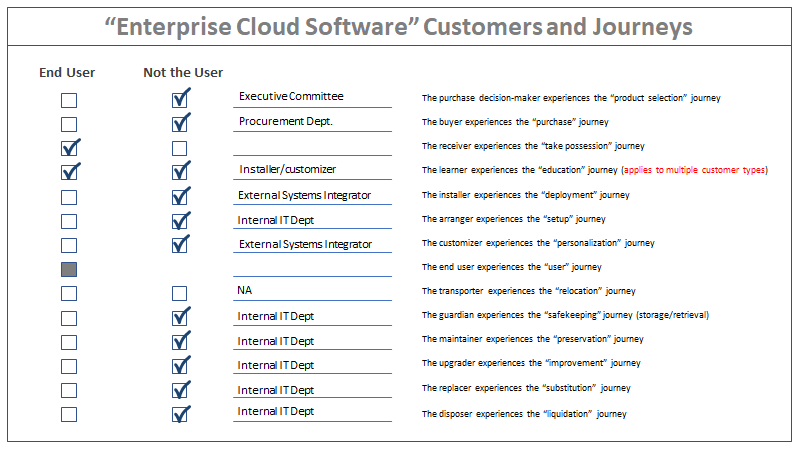I like to view customer experience as a combination of themes and capabilities that ensure the right product is designed for a problem, and the right set of integrated services are designed to support customers during various phases of solution ownership.
There are 14 common journeys I consider to be the starting point. Each of them have a predetermined map incorporating the objectives that a customer must reach each step of the way. This starting point ensures that no journey, or experiencer is overlooked.
I’ll share some of the maps and accelerators as I drill down in to the details of this framework over time.
Assuming you’ve identified a winning solution concept through core market innovation, you can begin to study how the services supporting the solution should be designed for the specific customer types that will experience specific journeys. Here is a list of 14 Universal Journeys that should be considered. Depending on the product/solution, they may, or may not apply.
- The Decision-maker experiences the Product Selection Journey — this is the process of deciding that a solution is necessary, and which solution to purchase. This could be the end user. However, parents frequently make decisions for their children, and executive committees often make budget decisions for corporate functions.
- The Buyer experiences the Purchase Journey — this is the process of actually acquiring the solution. This could be the end user or it could be a parent, or a subordinate, or a department. Understanding this is critical when you study the journey.
- The Receiver experiences the Take Possession journey — this is the process of taking physical ownership/control of the solution. In some cases this occurs at the point of sale, in other cases — both consumer and business — it could be a delivery, or something they must pickup at a later date.
- The Learner experiences the Education Journey — this is the process that an end user, or a third party must take to be education on solution use, solution setup, solution customization, etc. Therefore, this can actually be multiple journeys.
- The Installer experiences the Deployment Journey — this is the process of putting the solution in place for use. This could be performed by the end user, or it could require the services of a skilled third party.
- The Arranger experiences the Set up Journey — this is the process necessary to configure the solution for use. This could be the end user, or it could be a skilled third party for more complex solutions.
- The Customizer experiences the Personalization Journey — this is the process necessary to fine tune a solution specifically for the end user, or possibly another third party (such as an administrator in the software world). Some solutions are simple enough for end users to accomplish this, others will require a third party.
- The End User experiences the User Journey — the process of using the solution for the end user’s specific objective is always performed by the end user. The experience will generally tie back to the core functional objectives of the end user, as well as exceptional user interface design.
- The Transporter experiences the Relocation Journey — the process required to move a solution to another location for use, for storage, etc. Sometimes equipment must be relocated to a job site. This may or may not be done by the ultimate end user of the product.
- The Guardian experiences the Safekeeping Journey — this is the process of storage and retrieval of a solution (tools, files/information, etc.). And end user of a broom will store it in closet, or a system may automatically backup critically files to a redundant network.
- The Maintainer experiences the Preservation Journey — this is the process of preserver the functional or aesthetic properties of a solution. End users might clean a product, or hire technicians to fix a broken product, or contact technical support to troubleshoot a problem, etc.
- The Upgrader experiences the Improvement Journey — this is the process of applying new or improved features to a product/solution. Software is often upgraded, requiring an end user, engineer, or system to perform it. In other cases, a Jeep owner might enjoy adding new hardware to the vehicle as a weekend hobby.
- The Replacer experiences the Substitution Journey — this is the process that facilitates the substitution of one instance of a solution with another instance of the solution . End users might return a product received by Amazon, for example.
- The Disposer experiences the Liquidation Journey — this is the process a customer goes through to discard, or sell a product. A homeowner might hire a service to haul junk away, or they may try to sell it on eBay themselves.
Below is a simple way to plan things out for a particular product. It should be clear that an end user is not always the customer taking a journey; but they will always be impacted in some manner. Other customers that offer services to support the product life cycle also want optimal experiences while doing so. Therefore, you want to design for them as well.
Customer Experience is bigger than the end user

One last thing: only study a common set of customers. In other words, don’t study multiple end user segments where some might be do-it-yourselfers in the product life cycle journeys and others might be do-it-for-mes that prefer to hire service providers. They need to be studied and designed separately because there are a completely different set of expectations and needs.
Let me know what you think. More to come.



